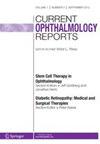Optimal fixation period of a combined bioconstruction with buccal epithelial cells in limbal cell deficiency in experiment
IF 0.8
Q4 OPHTHALMOLOGY
引用次数: 0
Abstract
BACKGROUND: The search for an effective method for the treatment of limbal stem cell deficiency of various etiologies, leading to intense clouding and vascularization of the cornea, followed by a significant decrease in visual acuity, remains an important and relevant topic in ophthalmology. The results of the studies showed that transplantation of buccal epithelial cells could significantly improve the prognosis of treatment in this category of patients. AIM: To determine the optimal fixation period of a combined bioconstruction with buccal epithelial cells for the treatment of limbal cell deficiency in experiment. MATERIALS AND METHODS: At the first stage, the corneal epithelium was removed with a scraper in the eyes of experimental animals (12 eyes), and the limb was excised along the entire circumference. Next, to isolate epithelial buccal cells and manufacture a combined bioconstruction consisting of buccal cells, a collagen carrier and a soft contact lens, a flap of the mucous membrane of 5 5 mm was taken from the cheeks of rabbits. At the second stage, after the formation of a fibrovascular pannus on the cornea, it was excised to transparent layers of the cornea, a combined bioconstruction was placed on top. Further, one U-shaped suture was applied at the border of the inner and outer third of the eyelids. Temporary blepharorraphia persisted for 3 days (6 eyes) and 5 days (6 eyes), after the specified time, stitches were removed from the eyelids, and bioconstructions were removed. The bioconstructions removed from the eyes were stained with a vital (lifetime) fluorochrome dye based on tripaflavin and acridine orange, followed by analysis in a fluorescent microscope. The structure of cell nuclei, the overall integrity of the cytoplasm, and the presence of secretory vesicles were evaluated. After 7 and 14 days after transplantation of the bioconstruction, the area of erosion, the extent of new vessels and the transparency of the cornea were evaluated. When the observation was completed, the rabbits were removed from the experiment, and the eyes were enucleated and subjected to histological examination. RESULTS: On the surface of all bioconstructions removed after 5 days, only leukocytes were detected. At the same time, on collagen matrix of bioconstructions removed after 3 days, in addition to leukocytes, there were also buccal epithelial cells with normal nuclear structure and chromatin topography in its composition, as well as with secretory vesicles. On days 714, both groups showed a decrease in the area of erosion, while the dynamics of ocular surface recovery processes was more pronounced in the group with fixation of the bioconstruction for 5 days. CONCLUSIONS: According to the results of in vivo staining with fluorochrome dye of combined bioconstructions removed from the cornea of experimental animals 3 and 5 days after superficial keratectomy, as well as the data of clinical and histological examination, the optimal period for bioconstruction fixation was established to be 5 days.唇缘细胞缺乏情况下口腔上皮细胞联合生物构建的最佳固定周期实验
背景:寻找一种有效的方法来治疗各种病因的角膜缘干细胞缺乏,导致角膜强烈混浊和血管化,随后视力显著下降,仍然是眼科的一个重要和相关的话题。研究结果表明,移植颊上皮细胞可显著改善该类患者的治疗预后。目的:通过实验确定口腔上皮细胞联合生物支架治疗角膜缘细胞缺乏症的最佳固定时间。材料与方法:第一阶段,实验动物(12只眼)眼内用刮板去除角膜上皮,沿整个周缘切除肢体。接下来,为了分离上皮颊细胞并制造由颊细胞、胶原载体和软接触镜组成的联合生物结构,我们从兔脸颊上取了5.5 mm的粘膜瓣。在第二阶段,在角膜上形成纤维血管膜后,将其切除至透明角膜层,并在其上放置联合生物构建物。此外,在眼睑内外三分之一的边界处应用u形缝线。暂时性眼睑缺损持续3天(6只眼)和5天(6只眼),在规定时间后,拆除眼睑缝线,拆除生物结构。从眼睛中取出的生物结构用基于地黄素和吖啶橙的重要(终身)荧光染料染色,然后在荧光显微镜下分析。细胞核的结构,细胞质的整体完整性和分泌囊泡的存在进行了评估。移植后第7天和第14天,观察角膜糜烂面积、新生血管形成程度和角膜透明度。观察结束后,将家兔从实验中取出,摘除眼球,进行组织学检查。结果:5天后去除的所有生物结构表面仅检测到白细胞。同时,在3天后取出的生物构建物胶原基质上,除白细胞外,还可见核结构和组成染色质形貌正常的颊上皮细胞,并可见分泌囊泡。在第714天,两组的侵蚀面积均有所减少,而固定5天的组眼表恢复过程的动态更为明显。结论:根据浅表角膜切除术后3、5 d实验动物角膜取出的联合生物构建物体内荧光染料染色结果,结合临床和组织学检查资料,确定生物构建物最佳固定时间为5 d。
本文章由计算机程序翻译,如有差异,请以英文原文为准。
求助全文
约1分钟内获得全文
求助全文
来源期刊

Current Ophthalmology Reports
Medicine-Ophthalmology
CiteScore
2.00
自引率
0.00%
发文量
22
期刊介绍:
This journal aims to offer expert review articles on the most significant recent developments in the field of ophthalmology. By providing clear, insightful, balanced contributions, the journal intends to serve those who diagnose, treat, manage, and prevent ocular conditions and diseases. We accomplish this aim by appointing international authorities to serve as Section Editors in key subject areas across the field. Section Editors select topics for which leading experts contribute comprehensive review articles that emphasize new developments and recently published papers of major importance, highlighted by annotated reference lists. An Editorial Board of more than 20 internationally diverse members reviews the annual table of contents, ensures that topics include emerging research, and suggests topics of special importance to their country/region. Topics covered may include age-related macular degeneration; diabetic retinopathy; dry eye syndrome; glaucoma; pediatric ophthalmology; ocular infections; refractive surgery; and stem cell therapy.
 求助内容:
求助内容: 应助结果提醒方式:
应助结果提醒方式:


